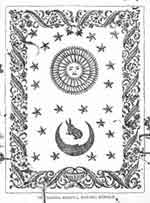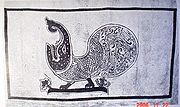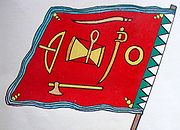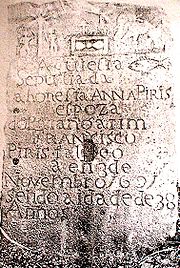
Karava Heraldry
Encyclopedia
The Karavas claim - on the basis of certain European commentaries - to be the only Sri Lanka
n community traditionally entitled to use flags. British Government Agents studying Sri Lankan flags during the early 20th century have noted that not a single flag could be found even in the residences of Kandyan chiefs, the Radala
nobility of the Kandyan Kingdom, as even they were not entitled to use flags. However it is known that the Kandyan Chieftains did not require household flags since each house bore the standard of the Korale (Province) under its jurisdiction and governance.
The modern Sri Lankan Karava community is also of interesting note for the energetic attempts it makes to reinterpret its status in the caste ranking system of the country. Traditionally set below the Govigama
caste, the Karava of colonial times rapidly allied themselves to the Colonial powers ( Portuguese
, Dutch
and English
) who ruled Sri Lanka. In the following centuries the Karava have created a semi-modern folklore of heraldry, etymology and traditions that attempt to establish them at the apex of the Sri Lankan caste structure. They have on occasion also succeeded , using this allegiance, in convincing the Colonial rulers of the veracity of such claims, leading to many erroneous Western writings on the Sri Lankan caste hierarchy during the 18th and 19th Centuries.
A large number of Karava flags have survived the ravages of time and many are illustrated in E. W. Perera
’s monumental book titled ‘Sinhalese Banners and Standards’. However despite the extent of the Karava collection of flags, he has scattered the Karava flags throughout the book and not given them a special chapter as they deserve. As such their significance is missed by most readers of his book.
These observations, made in the 19th Century, do not take into account that the Kandyans were living under a Sinhala Royal dominion that reserved the right to bear flags to the Palace, while the Karava were settled in the coastal lowlands that had been claimed from the Sri Lankan Kings by the Portuguese, and then the Dutch and English. Karava families in these areas no more owed allegiance to the kings of Lanka, and it is supposed that they took up customs prohibited to them in the feudal era as a response to their lowly status of their caste.
Further, none of these flags predate the occupation of the lowland Karava settlements by the West, establishing that none of these flags were from the period of the Sinhala Kings. However, the symbols on Karava flags are the sun, moon, stars, elephant, fish, white shield, pearl umbrella, swords, lotuses, and ship all of which were royal symbols in Sri Lanka’s past.
. Whosoever possessed this was acknowledged as the rightful ruler of Lanka, and thus the Tooth Relic was a possession exclusive to the ruling caste of Sri Lanka. Upon each change of capital, a new palace was built to enshrine the Relic. Finally, it was brought to Kandy
where it is at present, in the Temple of the Tooth
.
The oldest Buddhist sect in Sri Lanka, the Siam Nikaya
(estd. 19 July 1753) are the custodians of the Tooth Relic, since its establishment during the Kandyan Kingdom. The Siyam Nikaya traditionally grants Higher ordination only to the Radala
and Govigama
castes and excludes Karave and other lower castes completely from its numbers. Separate Sects exist for Karave castes, which have no claim to the Tooth Relic. Thus the Tooth Relic has been under exclusive ruling Govigama / Radala custody from the time of the Kings of Sri Lanka, predating the Colonial Era
Meanwhile the symbols on Karava flags - the sun, moon, stars, elephant, fish, white shield, pearl umbrella, swords, lotuses, ship all are claimed by the Karave to be royal symbols in Sri Lanka’s past. However, no conrete documentation of a Karave linkage to these symbols exists from pre-Colonial Sri Lankan history.


This most likely refers to one of the many Karava flags with the fish symbol, since the Karava have been traditionally fisherfolk in accordance with their lowly caste status. Some however contend that it may also mean the Makara flag which is widely used in Karava ceremonies (fish and dragons both have scales). The Makara
, is a composite dragon with a curious mythical structure. It symbolizes the house of Capricorn
in the Zodiac
to which it has given its name Makara in the Hindu calendar
. It has the head of a crocodile, horns of a goat, the body of an antelope and a snake, the tail of a fish and feet of a panther. Makara is half animal half fish and it is sometimes described as having the head of an elephant and the body of a fish. It is generally large and regarded as living in the ocean rather than in lakes or streams.
Only Varuna
, the spiritual ruler of the world has power over the Makara. It is Varuna’s vehicle in Hindu mythology. As most Karavas in southern Sri Lanka belong to the Karava Varunakulasuriya clan, the symbolism is extremely interesting. In mythology Varuna
is the chief of the Adithya
s. Remnants of the name Adithya from the medieval period can still be found in Karava family names. As Adithya is a synonym for Suriya (i.e. the Sun). the Karava clan Varunakulasuriya too signifies Varuna-Adithya.
 See Fish and ship symbols of Sri Lanka for the significance of the Fish and Ship symbols on these flags.
See Fish and ship symbols of Sri Lanka for the significance of the Fish and Ship symbols on these flags.
, Hastinapura
which means Elephant city, the capital of the Kaurava
kingdom. The great war of the epic Mahabharata
is fought over the throne of this city and most incidents in the epic take place in this city. The Sri Lankan chronicle Rajavaliya states that the elephant flag was prominent in Mayadunne's son, prince Rajasinghe's battle at Mulleriyawa against the Portuguese.

 The tombstone of Patangatim Francisco Piris’ wife from St. Thomas Church, Jinthupitiya illustrated here, shows that the Karava heraldic symbols: Pearl umbrella, Palm tree, caparisoned Elephant and Fish symbol were used even on tombstones (JRASCB XXII 387)
The tombstone of Patangatim Francisco Piris’ wife from St. Thomas Church, Jinthupitiya illustrated here, shows that the Karava heraldic symbols: Pearl umbrella, Palm tree, caparisoned Elephant and Fish symbol were used even on tombstones (JRASCB XXII 387)
(Perera 34, Kurukula Charitaya II 26)
Sri Lanka
Sri Lanka, officially the Democratic Socialist Republic of Sri Lanka is a country off the southern coast of the Indian subcontinent. Known until 1972 as Ceylon , Sri Lanka is an island surrounded by the Indian Ocean, the Gulf of Mannar and the Palk Strait, and lies in the vicinity of India and the...
n community traditionally entitled to use flags. British Government Agents studying Sri Lankan flags during the early 20th century have noted that not a single flag could be found even in the residences of Kandyan chiefs, the Radala
Radala
The Radala refer to an extremely small minority caste in the Kandyan Kingdom of Sri Lanka. They were the aristocracy of the Kandyan Kingdom. After capturing the Kandyan provinces in 1815 with the aid of locals from both maritime and Kandyan provinces, the British created an extensive class of loyal...
nobility of the Kandyan Kingdom, as even they were not entitled to use flags. However it is known that the Kandyan Chieftains did not require household flags since each house bore the standard of the Korale (Province) under its jurisdiction and governance.
The modern Sri Lankan Karava community is also of interesting note for the energetic attempts it makes to reinterpret its status in the caste ranking system of the country. Traditionally set below the Govigama
Govigama
Govi, Govigama, Goigama, Goygama, Goyigama, Goviyo is the most influential and the dominant Caste in Sri Lanka and certainly comes as the leading cast in the hierarchy of cast system in Sri Lanka.The term Govi denotes farmer.From time immemorial the Govigama have been the landlords and have been...
caste, the Karava of colonial times rapidly allied themselves to the Colonial powers ( Portuguese
Portugal
Portugal , officially the Portuguese Republic is a country situated in southwestern Europe on the Iberian Peninsula. Portugal is the westernmost country of Europe, and is bordered by the Atlantic Ocean to the West and South and by Spain to the North and East. The Atlantic archipelagos of the...
, Dutch
Netherlands
The Netherlands is a constituent country of the Kingdom of the Netherlands, located mainly in North-West Europe and with several islands in the Caribbean. Mainland Netherlands borders the North Sea to the north and west, Belgium to the south, and Germany to the east, and shares maritime borders...
and English
England
England is a country that is part of the United Kingdom. It shares land borders with Scotland to the north and Wales to the west; the Irish Sea is to the north west, the Celtic Sea to the south west, with the North Sea to the east and the English Channel to the south separating it from continental...
) who ruled Sri Lanka. In the following centuries the Karava have created a semi-modern folklore of heraldry, etymology and traditions that attempt to establish them at the apex of the Sri Lankan caste structure. They have on occasion also succeeded , using this allegiance, in convincing the Colonial rulers of the veracity of such claims, leading to many erroneous Western writings on the Sri Lankan caste hierarchy during the 18th and 19th Centuries.
A large number of Karava flags have survived the ravages of time and many are illustrated in E. W. Perera
E. W. Perera
Edward Walter Perera was a Ceylonese barrister, politician and freedom fighter. He was known as the 'Lion of Kotte' and was a prominent figure in the Sri Lankan independence movement and a Senator....
’s monumental book titled ‘Sinhalese Banners and Standards’. However despite the extent of the Karava collection of flags, he has scattered the Karava flags throughout the book and not given them a special chapter as they deserve. As such their significance is missed by most readers of his book.
These observations, made in the 19th Century, do not take into account that the Kandyans were living under a Sinhala Royal dominion that reserved the right to bear flags to the Palace, while the Karava were settled in the coastal lowlands that had been claimed from the Sri Lankan Kings by the Portuguese, and then the Dutch and English. Karava families in these areas no more owed allegiance to the kings of Lanka, and it is supposed that they took up customs prohibited to them in the feudal era as a response to their lowly status of their caste.
Further, none of these flags predate the occupation of the lowland Karava settlements by the West, establishing that none of these flags were from the period of the Sinhala Kings. However, the symbols on Karava flags are the sun, moon, stars, elephant, fish, white shield, pearl umbrella, swords, lotuses, and ship all of which were royal symbols in Sri Lanka’s past.
The Symbols
For the past 2,500 years the only undisputed symbol of Sri Lankan Royalty and Leadership has been the sacred Tooth Relic of Gautama BuddhaGautama Buddha
Siddhārtha Gautama was a spiritual teacher from the Indian subcontinent, on whose teachings Buddhism was founded. In most Buddhist traditions, he is regarded as the Supreme Buddha Siddhārtha Gautama (Sanskrit: सिद्धार्थ गौतम; Pali: Siddhattha Gotama) was a spiritual teacher from the Indian...
. Whosoever possessed this was acknowledged as the rightful ruler of Lanka, and thus the Tooth Relic was a possession exclusive to the ruling caste of Sri Lanka. Upon each change of capital, a new palace was built to enshrine the Relic. Finally, it was brought to Kandy
Kandy
Kandy is a city in the center of Sri Lanka. It was the last capital of the ancient kings' era of Sri Lanka. The city lies in the midst of hills in the Kandy plateau, which crosses an area of tropical plantations, mainly tea. Kandy is one of the most scenic cities in Sri Lanka; it is both an...
where it is at present, in the Temple of the Tooth
Temple of the Tooth
Sri Dalada Maligawa or The Temple of the Sacred Tooth Relic is a Buddhist temple in the city of Kandy, Sri Lanka. It is located in the royal palace complex which houses the Relic of the tooth of Buddha. Since ancient times, the relic has played an important role in local politics because it is...
.
The oldest Buddhist sect in Sri Lanka, the Siam Nikaya
Siam Nikaya
The Siam Nikaya is a monastic order within Sri Lanka, founded by Upali Thera and located predominantly around the city of Kandy. It is so named because it originated within Thailand...
(estd. 19 July 1753) are the custodians of the Tooth Relic, since its establishment during the Kandyan Kingdom. The Siyam Nikaya traditionally grants Higher ordination only to the Radala
Radala
The Radala refer to an extremely small minority caste in the Kandyan Kingdom of Sri Lanka. They were the aristocracy of the Kandyan Kingdom. After capturing the Kandyan provinces in 1815 with the aid of locals from both maritime and Kandyan provinces, the British created an extensive class of loyal...
and Govigama
Govigama
Govi, Govigama, Goigama, Goygama, Goyigama, Goviyo is the most influential and the dominant Caste in Sri Lanka and certainly comes as the leading cast in the hierarchy of cast system in Sri Lanka.The term Govi denotes farmer.From time immemorial the Govigama have been the landlords and have been...
castes and excludes Karave and other lower castes completely from its numbers. Separate Sects exist for Karave castes, which have no claim to the Tooth Relic. Thus the Tooth Relic has been under exclusive ruling Govigama / Radala custody from the time of the Kings of Sri Lanka, predating the Colonial Era
Meanwhile the symbols on Karava flags - the sun, moon, stars, elephant, fish, white shield, pearl umbrella, swords, lotuses, ship all are claimed by the Karave to be royal symbols in Sri Lanka’s past. However, no conrete documentation of a Karave linkage to these symbols exists from pre-Colonial Sri Lankan history.


The Makara
Beknopte History, 1688 describes a white flag charged with a red flag hoisted on royal ships (JRASCB XI No.38 106 & 109). And in the words of Valentine Francois, the 18th century Dutch Historian, “the Karawas displayed a white flag with the device of a particular fish in the centre".This most likely refers to one of the many Karava flags with the fish symbol, since the Karava have been traditionally fisherfolk in accordance with their lowly caste status. Some however contend that it may also mean the Makara flag which is widely used in Karava ceremonies (fish and dragons both have scales). The Makara
Makara (Hindu mythology)
Makara is a sea-creature in Hindu mythology. It is generally depicted as half terrestrial animal and in hind part as aquatic animal, in the tail part, as a fish tail or also as seal...
, is a composite dragon with a curious mythical structure. It symbolizes the house of Capricorn
Capricornus
Capricornus is one of the constellations of the zodiac; it is often called Capricorn, especially when referring to the corresponding astrological sign. Its name is Latin for "horned male goat" or "goat horn", and it is commonly represented in the form of a sea-goat: a mythical creature that is half...
in the Zodiac
Zodiac
In astronomy, the zodiac is a circle of twelve 30° divisions of celestial longitude which are centred upon the ecliptic: the apparent path of the Sun across the celestial sphere over the course of the year...
to which it has given its name Makara in the Hindu calendar
Hindu calendar
The hindu calendar used in ancient times has undergone many changes in the process of regionalization, and today there are several regional Indian calendars, as well as an Indian national calendar. Nepali calendar, Bengali calendar, Malayalam calendar, Tamil calendar, Telugu calendar, Kannada...
. It has the head of a crocodile, horns of a goat, the body of an antelope and a snake, the tail of a fish and feet of a panther. Makara is half animal half fish and it is sometimes described as having the head of an elephant and the body of a fish. It is generally large and regarded as living in the ocean rather than in lakes or streams.
Only Varuna
Varuna
In Vedic religion, Varuna is a god of the sky, of water and of the celestial ocean, as well as a god of law and of the underworld...
, the spiritual ruler of the world has power over the Makara. It is Varuna’s vehicle in Hindu mythology. As most Karavas in southern Sri Lanka belong to the Karava Varunakulasuriya clan, the symbolism is extremely interesting. In mythology Varuna
Varuna
In Vedic religion, Varuna is a god of the sky, of water and of the celestial ocean, as well as a god of law and of the underworld...
is the chief of the Adithya
Adithya
Adithya , is an Indian film actor who appears in Tamil, Telugu and Malayalam films. He is an atheist.- Filmography:-External links:...
s. Remnants of the name Adithya from the medieval period can still be found in Karava family names. As Adithya is a synonym for Suriya (i.e. the Sun). the Karava clan Varunakulasuriya too signifies Varuna-Adithya.
- The Kokila Sandesha poem from the KotteKotteSri Jayawardenapura Kotte , also known as Sri Jayawardenapura or Kotte කෝට්ටේ, is the administrative capital of Sri Lanka. It is located beyond the eastern suburbs of the commercial capital Colombo and is often called New Capital Territory...
period refers to the Makara flag as follows:- Punsanda surindu sanda salakuna adina vara
- Ban sonda telitudew tele tudeni mana hara
- Min dada jaya virudu nada karana piya kara
- An koda mediya tura topa sarivana pavara

The Elephant
The recurrent Elephant symbol may be from the MahabharataMahabharata
The Mahabharata is one of the two major Sanskrit epics of ancient India and Nepal, the other being the Ramayana. The epic is part of itihasa....
, Hastinapura
Hastinapura
Hastinapur is a town and a nagar panchayat in Meerut district in the Indian state of Uttar Pradesh.-History:Hastinapur was the capital of the kingdom of the Kauravas, belonging to the Kuru dynasty of kings. The throne of this city was the prize over which the Kurukshetra War of the epic...
which means Elephant city, the capital of the Kaurava
Kaurava
The term Kaurava is a Sanskrit term, that means the descendants of Kuru, a legendary king who is the ancestor of many of the characters of the Mahābhārata.The term is used in the Mahābhārata with two meanings:...
kingdom. The great war of the epic Mahabharata
Mahabharata
The Mahabharata is one of the two major Sanskrit epics of ancient India and Nepal, the other being the Ramayana. The epic is part of itihasa....
is fought over the throne of this city and most incidents in the epic take place in this city. The Sri Lankan chronicle Rajavaliya states that the elephant flag was prominent in Mayadunne's son, prince Rajasinghe's battle at Mulleriyawa against the Portuguese.


The White shield
The white shields known as sak paliha or conch shields were also important royal symbols in Sri Lanka's history. The Karava ancestral flag illustrated above displays two of them. The sak paliha was a white shield sometimes with the devise of a conch shell on it and is referred to frequently as a royal symbol in Sinhalese historical texts. According to the Portuguese historian De Couto, it was also used as a royal symbol ( JRASCB XX 187 ).Usage by kin-groups in India
Across the Palk Strait, the kinsmen of the Karavas too have used similar insignia in the past. H. R. Pate describes a wedding as follows: A peculiar feature of the wedding is the procession to the bride’s house with virudus or banners supposed to be the insignia of the Kingly ancestors of the race. The emblems consist of 21 flags embroidered with representations of various objects, animate and inanimate, such as a Snake, a Peacock, a Palmyra, a Chank, the Sun and Moon an Elephant. A Fish and so on. In addition to these a large Umbrella, a Shield and other trappings are carried. The bridegroom wears a costume called KAPA resembling the state robes of Jathi Thalavi More and white cloths are spread before hi in his path. (Madras District Gazetteer 123 & 124)The Chandra Kula Maalawa
An old document called the ‘Chandrakula Malawa’ from the Pitigal Korale enumerates the following 21 flags as belonging to the Kurukula:- Naga Kodiya (Cobra flag)
- Kukulu Kodiya (Cock flag)
- Monara Kodiya (Peacock flag)
- Talgaha bendi Kodiya (Talipot palm flag)
- Newa bendi Kodiya (Ship flag)
- Hakgediya bendi Kodiya (Chank flag)
- Sippiya Kodiya (Sea shell flag)
- Kotiya bendi Kodiya (Leopard flag)
- Sinhaya bendi Kodiya (Lion flag)
- Rajaliya bendi Kodiya (Eagle flag)
- Hansaya bendi Kodiya (Swan flag)
- Tanmetta bendi Kodiya (Kettle drum flag)
- Surya Kodiya (Sun flag)
- Chandrabendi Kodiya (Moon flag)
- Etha bendi Kodiya (Elephant flag)
- Gona bendi Kodiya (Bull flag)
- Makaraya bendi Kodiya (Makara flag)
- Thel Kodiya (Net flag)
- Matsaya Kodiya (Fish flag)
- Hanumantha Kodiya (Hanuma flag)
- Girava bendi Kodiya (Parrot flag)
(Perera 34, Kurukula Charitaya II 26)
External links
- Karava web site - Kshatriya Maha Sabha Sri Lanka http://www.crazylanka.com
- The Ceylon Antiquary and literary Register, July 1921 http://www.defonseka.com/karave_flag.htm
- Karava Flags http://www.defonseka.com/karava_flags_other01.htm

